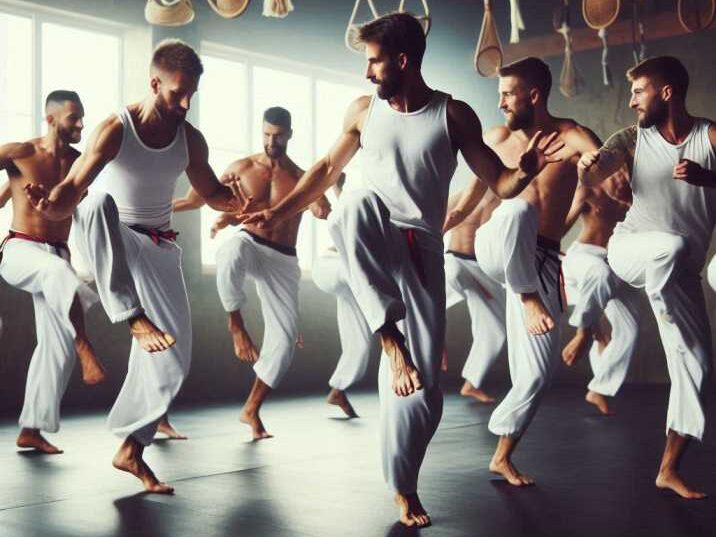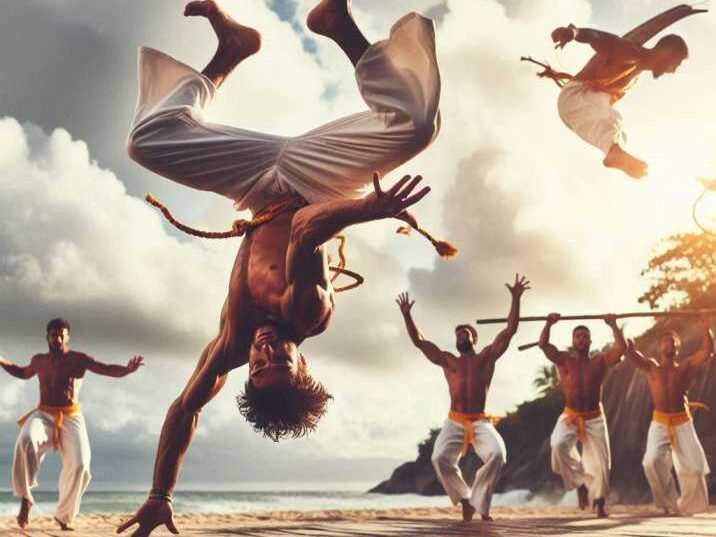Introduction
Table of Contents
Brazilian culture is home to many vibrant traditions, and capoeira stands out as one of the most unique. Often referred to as the Brazilian martial art dance, capoeira combines self-defense, acrobatic movements, and music into an energetic, rhythmic experience. While it looks like a graceful dance, it also serves as an effective martial art, offering a rich blend of physical agility, mental discipline, and cultural history.

In this article, we’ll dive deep into the world of capoeira, explore its origins, techniques, and how it improves focus and discipline. By the end, you’ll have a thorough understanding of this powerful Brazilian tradition and its benefits for all ages.
The Origins of Capoeira: A Blend of Cultures
A Historical Overview
Capoeira was developed by enslaved Africans brought to Brazil during the 16th century. They used the dance-like movements of capoeira as a way to disguise self-defense practice from their captors. What started as a survival tool has evolved into a unique and treasured art form.
The fusion of African fighting techniques and native Brazilian traditions resulted in capoeira becoming a symbol of resilience, freedom, and expression. Today, it’s practiced worldwide and celebrated for its cultural and historical significance.
Why is Capoeira Both a Dance and a Martial Art?
Capoeira’s movements are set to music, making it appear like a dance. However, behind the fluid kicks, spins, and flips are powerful self-defense techniques. The rhythm of the berimbau (a traditional Brazilian instrument) and the chanting of songs set the pace for practitioners, also known as capoeiristas.
The combination of music and movement makes capoeira distinct from other martial arts. The graceful techniques, paired with high-energy acrobatics, allow participants to defend themselves while maintaining their balance, flexibility, and rhythm.
Capoeira Techniques: Graceful Yet Powerful
Capoeira is a unique blend of martial arts, dance, and acrobatics. Its techniques emphasize fluidity, speed, and adaptability, making it both graceful and powerful. Let’s dive deeper into some of the key moves that define this martial art.
The Ginga: Capoeira’s Signature Move
At the core of capoeira is the ginga (pronounced “jeen-gah”), a rhythmic, swaying movement that keeps the capoeirista (capoeira practitioner) constantly in motion. Unlike other martial arts, where fighters might remain stationary while planning their next move, capoeira’s ginga ensures that the body is always active and ready to attack or defend.
The ginga is performed by moving from side to side in a triangular pattern, with one leg stepping back while the arms move in a defensive position. This fluid motion serves several purposes:
- Mobility: It allows the capoeirista to move quickly across the floor, making them a difficult target to hit.
- Deception: The swaying movement disguises the capoeirista’s next attack, keeping the opponent guessing.
- Balance and Flow: Ginga prevents static positions, ensuring that the fighter remains balanced and ready to react at any moment. It also helps maintain the rhythm, which is central to capoeira.
The ginga is more than just a move—it sets the tone for the entire game of capoeira, giving practitioners the flexibility to dodge, kick, and spin in a continuous flow of motion.
Kicks and Spins
Capoeira’s attacks are centered around fast, fluid kicks and spins, which are often unpredictable and difficult to counter. Many of these moves are performed with impressive acrobatic skill, blending offense and defense seamlessly. Some of the most common and effective kicks include:
- Meia Lua de Frente (Half-Moon Kick): This is a sweeping, crescent-shaped kick that is performed by swinging the leg in a wide arc, aiming to strike the opponent’s head or upper body. The meia lua is graceful yet powerful, using the body’s full momentum to deliver a forceful blow.
- Armada (Spinning Kick): The armada is a spinning kick where the capoeirista turns their body 360 degrees before extending their leg in a wide, sweeping arc. The spin not only adds power but also creates an element of surprise, making it hard for opponents to predict or block the kick.
- Martelo (Hammer Kick): This kick is delivered with the heel of the foot, driving downwards like a hammer. The martelo is used to target the opponent’s head or upper body and is often combined with spinning or jumping to increase its impact.
These kicks are often paired with handstands, cartwheels, and other acrobatic movements to evade attacks and create unexpected openings for counterattacks. The goal of capoeira is to maintain constant movement, leaving little room for the opponent to predict the next move.
Additionally, capoeiristas use spins and flips not just for defense but also to showcase agility and creativity. By incorporating these spins and aerial moves, they can quickly dodge an opponent’s attack while positioning themselves for a counterstrike.
Acrobatic Moves
Practicing Capoeira is not just about kicks; it also incorporates acrobatics:
- Handstands and Cartwheels: These movements serve both defensive and offensive purposes. They can evade attacks while creating openings for counterattacks.
- Fluid Transitions: The combination of acrobatics with strikes allows capoeiristas to maintain unpredictability, making it difficult for opponents to anticipate their next move.
These moves, along with handstands and cartwheels, are used to evade attacks and create openings for counterattacks. The goal is to remain unpredictable, keeping opponents on their toes.
Acrobatics and Flexibility
Capoeira is well-known for its impressive acrobatics. Movements like au (cartwheel) and macaco (backward flip) are used not only for offense and defense but to showcase flexibility and control. The flips and twists performed in capoeira give it the appearance of a choreographed dance, further enhancing its artistic nature.

The Importance of Focus and Discipline in Practicing Capoeira
Practicing Capoeira requires concentration and discipline, two qualities that translate beyond the martial art itself. Practicing capoeira strengthens mental focus, helping individuals excel in school, work, and other activities.
How Capoeira Builds Focus
- Coordination: The integration of music, movement, and timing helps practitioners sharpen their coordination, improving their attention to detail in other tasks.
- Memory: Remembering song lyrics, movements, and sequences of kicks challenges the brain, which can improve memory skills.
- Discipline: Capoeira requires regular practice, patience, and persistence. These traits build mental discipline that can help individuals stay committed to other goals in life.
Impact on School and Life
Children and teens who practice capoeira often see improvements in their focus at school. The discipline learned from mastering difficult movements and synchronizing with music can boost concentration on tasks like reading, writing, and math. Additionally, it fosters self-confidence and teamwork, which are valuable life skills.
Capoeira in Modern Times: A Global Art Form
Capoeira Schools and Competitions
Today, capoeira is practiced by millions of people around the world. Many countries have capoeira schools, known as academias, where students learn the art. The roda (a circle formed by capoeiristas and musicians) is the center stage for capoeira matches. These matches, known as jogos, are both playful and competitive.
In addition to traditional practices, capoeira is also featured in international competitions, festivals, and shows. The athleticism and grace involved in capoeira continue to mesmerize audiences globally.
Benefits of Practicing Capoeira
Practicing Capoeira offers numerous physical and mental health benefits. Let’s break down some of the key advantages of this unique martial art.
1. Improved Flexibility
Practicing capoeira involves a wide range of acrobatic moves, such as kicks, cartwheels, and flips. These dynamic movements require the body to stretch in various directions, promoting greater flexibility. Regular practice helps to stretch and tone muscles, making the body more limber and reducing the risk of injury. Flexibility is key for maintaining a full range of motion, which is essential for everyday activities and sports. As you become more flexible, your movements in capoeira become more fluid and graceful, helping you perform complex kicks and acrobatics more effectively.
2. Strength Building
Practicing Capoeira is a full-body workout. It engages major muscle groups such as the arms, legs, core, and back. Moves like the ginga, various kicks, and acrobatics build muscle strength and endurance over time. As you perform flips and balance moves, you are constantly using your own body weight for resistance, which strengthens your muscles without the need for weights. Additionally, capoeira requires explosive power in the legs for high kicks and jumps, while core strength is necessary to maintain balance during quick changes of movement. As a result, capoeira helps tone the body and improve overall strength and stability.
3. Mental Agility
Practicing capoeira is not just a physical workout—it’s also a mental one. The art form requires players to think quickly and adapt to the unpredictable movements of their opponents. The music, rhythm, and fast-paced nature of capoeira force practitioners to stay mentally sharp, react in real-time, and anticipate their opponent’s next move. This mental agility is crucial for improving concentration and decision-making. Moreover, capoeiristas must memorize complex sequences of movements and respond to changes in rhythm, which can improve memory, focus, and problem-solving skills. These cognitive benefits extend beyond capoeira, helping individuals perform better in school, work, and daily life.
4. Cultural Appreciation
One of the most enriching aspects of capoeira is its deep cultural roots. Capoeira carries the rich history of African slaves in Brazil and their fight for freedom and survival. Practicing capoeira teaches respect for Brazilian history and the African influences that helped shape the art. Through the music, songs, and movements, participants learn about resilience, creativity, and the power of cultural expression. Capoeira also fosters a sense of community, as practitioners typically engage in a roda (circle), where they interact, share, and respect each other’s contributions. By engaging in this cultural tradition, participants develop a greater appreciation for diversity and the history of those who shaped capoeira into what it is today.
Conclusion: The Dance of Strength and Grace
In conclusion, What is the name of the Brazilian Martial Arts Dance? Capoeira is more than just a martial art—it’s a cultural expression, a physical workout, and a mental challenge all rolled into one. Its combination of dance, music, and self-defense makes it stand out from other martial arts. Whether you’re looking to improve your discipline, learn about a new culture, or get in shape, capoeira offers something for everyone.
Table of Information about Brazilian Martial Arts Dance
| Capoeira Element | Description |
|---|---|
| Origin | Developed by enslaved Africans in Brazil during the 16th century |
| Main Movement (Ginga) | A swaying motion used to set up attacks and dodge opponent strikes |
| Key Techniques | Kicks (Meia lua, Armada), Acrobatics (Au, Macaco) |
| Cultural Significance | A symbol of resistance, freedom, and African-Brazilian cultural heritage |
| Physical Benefits | Improves flexibility, strength, coordination, and mental focus |
FAQs
- What is the name of the Brazilian martial arts dance?
The name is capoeira, which blends dance, music, and martial arts. - Is capoeira effective for self-defense?
Yes, while it looks like a dance, it includes powerful self-defense techniques. - What instruments are used in capoeira?
The berimbau, pandeiro, and atabaque are commonly used in capoeira music. - Can kids practice capoeira?
Absolutely! Capoeira helps kids build focus, discipline, and coordination. - Is capoeira hard to learn?
Like any martial art, it takes time and practice, but beginners can start with basic movements.


